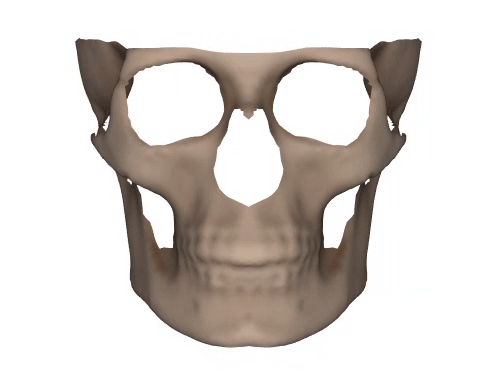The field of phenomics
which involves the understanding of qualitative and quantitative traits characterizing a phenotype, has rapidly developed over the past two decades.
Numerous publications have revealed genetic variants associated with facial phenotypes using advanced phenotyping methodologies. However, despite significant strides in understanding facial soft tissue variation, the underlying facial bone structure has remained largely unexplored due to the intricate nature of the entire skull shape and challenges in acquiring large numbers of 3D scans.
Understanding facial bone structure is crucial for a holistic understanding of genetic determinants governing human facial shape. Studies on the shape of the human skull have traditionally been in anthropology, where skull shape can categorize sex and broad ancestral origins. Computational tools and shape analyses have been used for various purposes, including ancestry estimation, facial reconstruction, and medical applications.Recent advancements, such as the MeshMonk framework, provide a standardized method for 3D dense phenotyping of facial soft tissue.
This work introduces a simplified mesh focused on facial bones and the frontal region of the skull, compatible with MeshMonk, thus facilitating large-scale genetic studies exploring the hard structures of the human face.
Our hard-tissue facial bone mask broadens the potential scope of phenomics research and enables a comprehensive exploration of genetic determinants underlying human skull morphology, particularly facial bone structure.
Figure 1 and 2 illustrate the use of this mask to visualize the morphological variation observed within craniofacial bone structure using over 30 individuals when exploring PCA (PC1) and Sexual Dimorphism, respectively.


To aid in the use of our mask, we have supplied the following files:
1. AverageSkullMask.obj – This the .obj file of the skull mask
2. Reflection Index – This table lists all vertex IDs on the mask and which VertexID is their reflection to allow easy symmetrisation of masked skulls
3. Gap IDs – This table lists all vertices that are not “true” vertices (i.e. fill gaps such as the orbits)
4. CBCT Export And Shrinkwrap Protocol – An instruction manual on how to export CBCT meshes from DICOM files and prepare them for MeshMonk
5. ShrinkWrapSkull.blend – This is the Blender file required for the instructions above on how to shrink-wrap the skull
6. MatLabScript_QualityControlImages.m – This is a MATLAB script that is complementary to MeshMonk and can be run after the masking process is complete to produce images that show the mask overlaying the original mesh as a form of quality control
This work was funded by a National Institute of Health (NIH) R15 grant (1R15DE031929), please acknowledge this grant and cite the following publication when using this data.
Wilke F, Matthews H, Herrick N, Dopkins N, Claes P, Walsh S. A novel approach to craniofacial analysis using automated 3D landmarking of the skull. 2024. Scientific Reports, vol 14:12381.